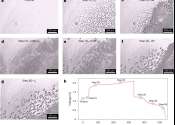Iodine (pronounced /ˈaɪ.ədaɪn/, /ˈaɪ.ədɨn/, or in chemistry /ˈaɪ.ədiːn/; from Greek: ιώδης iodes "violet"), is a chemical element that has the symbol I and atomic number 53. Naturally-occurring iodine is a single isotope with 74 neutrons.
Chemically, iodine is the second least reactive of the halogens, and the second most electropositive halogen; trailing behind astatine in both of these categories. However, the element does not occur in the free state in nature. As with all other halogens (members of Group XVII in the periodic table), when freed from its compounds iodine forms diatomic molecules (I2).
Iodine and its compounds are primarily used in medicine, photography, and dyes. Although it is rare in the solar system and Earth's crust, the iodides are very soluble in water, and the element is concentrated in seawater. This mechanism helps to explain how the element came to be required in trace amounts by all animals and some plants, being the heaviest element commonly used by living organisms (only tungsten, used in enzymes by a few bacteria, is heavier).


